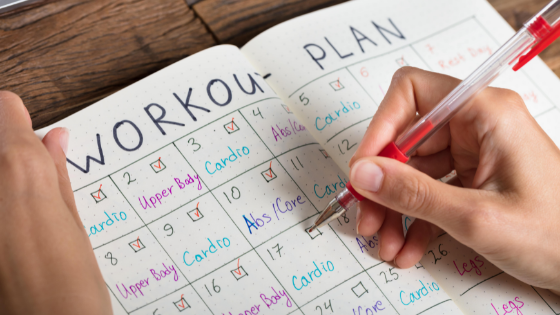We’ve all been there. You walk into a gym and think ‘what should I do?’. You glance around and see your go-to leg press machine taken, or the stretching area occupied, and your plan goes out the window. For most people having a go at weight training - whether its resistance training, strength or hypertrophy - it can be a little confusing knowing what to do, whether that’s selecting the exercises, choosing the rep range, or deciding which order they should go in. There is, however, an easy little guide to plan a full body weight training workout, if you are in doubt!
The key is 4, 3, 2.
4 Compound Exercises

After a thorough warm up, it’s sometimes best to start your workout with the biggest exercises first. This way you ensure your muscles are as refreshed and ‘energy loaded’ as possible, for these are exercises that use the most muscles and move the most weight. These ‘big’ exercises are termed ‘compound exercises’. Specifically, a compound exercise involves moving through two or more sets of joints. If you’re doing a full body workout, I recommend you alternate between body parts to not fatigue yourself. For example, follow a squat with a chest press, not a leg press. Some of the major compound exercises are:
- Squat
- Leg Press
- Bench press/Chest Press
- Lat pull-down
- Press ups
- Deadlift (conventional or romanian variation)
- Row (of any variation)
- Shoulder Press
- Glute Bridge
3 Isolation Exercises

After you’ve done your compound exercises, you can move to your 3 isolation exercises. Isolation exercises are moves that only go through one joint, and they tend to focus on one muscle as well, such as bicep curls. The logic of doing these after your compound exercises is two fold. Firstly, they’re less energy consuming, meaning it's OK that you’re a little fatigued already since you’re not loading 100kg+ through your body. Secondly, these movements act to bring specific muscle groups to true exhaustion through isolation, having already been partially fatigued through heavier compound movements. Post-compound isolation maximizes benefits of muscle growth etc. Isolation exercises include…
- Bicep curls
- Tricep curls/dips/extensions
- Shoulder raises (lateral, frontal)
- Chest and/or prone fly
- Leg extensions and leg curls
- Abductor and adductor work
- Calf raises
2 Core Exercises

Yes, that’s right. Core gets its own section. Often neglected, core exercises should really get 5 minutes in the spotlight within our workouts, but it doesn’t need to be arduous. I advise you to pick 2 core exercises to complete at the end of your workout(s), and although it may not get you that six pack, it will keep your core strong, your back supported, and even aid digestion.
Some top core exercises are…
- Crunches and reverse crunches
- Plank (of any variation)
- Sit ups
- Leg raises (or knee raises)
- Oblique twists
- Bird Dogs
- Cable core twists (sometimes called the woodchop)
- Back extensions
Repetitions and Sets
A repetition is the term given for performing a single movement once. For example, performing one squat is one repetition. One ‘set’ is a group of a certain number of repetitions. Your rep and set range depends on your ability as well as your goals. As a basic indication, if you’re new to weight training or the weights room, aim for between 1-2 sets of 12-20 reps. This will ensure you're working on your muscular endurance whilst developing on technique through muscle memory. For hypertrophy (muscle mass gain), think 3-4 sets of 8-12 reps. Finally, for strength training (heavy) and power training, you’re looking at 3-6 sets of anything between 3-6 reps. I would urge caution for doing anything less than 3 reps or going for 1 rep max attempts unless you’re very comfortable, have experience and have somebody ‘spotting’ you. When trying to determine the correct weight or intensity to work out, you should finish each set thinking you could have done 1 or two more repetitions.
Rest
My final recommendation is rest. Rest is often ignored and underestimated. It feels counter-productive. Part of this is our indoctrinated belief that in order to make exercise worthwhile and beneficial we need to be working non-stop for 60 minutes, and be really out of breath for the entire workout. With weight training this is far from true. In order to ensure sufficient energy production within our glycogen stores and muscle fibres, our bodies need to rest for a few minutes. If you’re doing muscular endurance, between a minute and minute and a half is sufficient. For hypertrophy, aim for between 2-3 minutes depending on how hard you’re working, and anything for strength and power could be between 3-5 minutes. The determining factor for making sure you’ve had sufficient rest is whether or not you achieve the repetition goal at your next set.
So there you have it. An easy way to plan a workout if you find yourself lost and wondering what to do. A simple drag and drop of the different exercise lists, and go from there. The list above is not exhaustive and of course not the only option. Of course, do remember to warm up, stretch and have a cool down, and always have some water with you.
